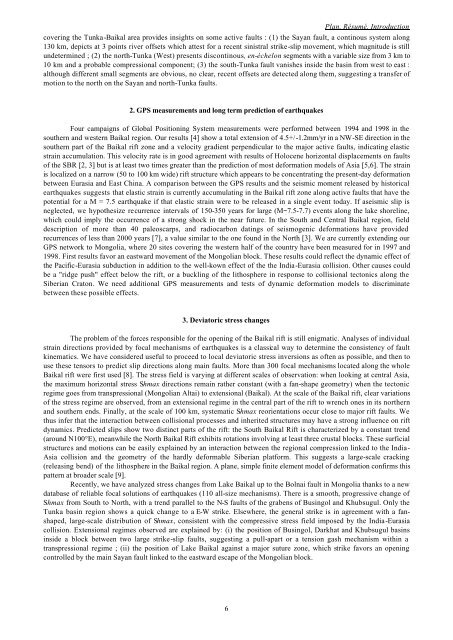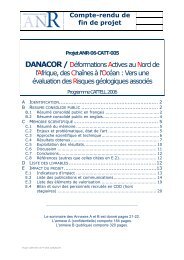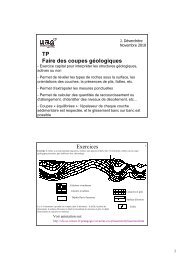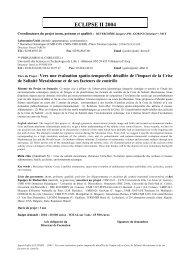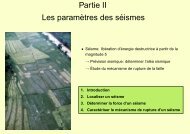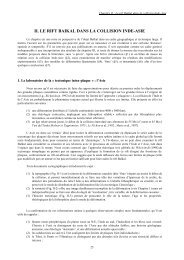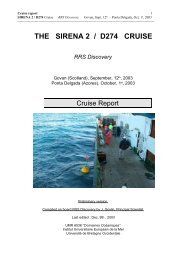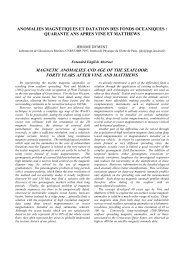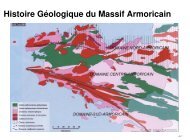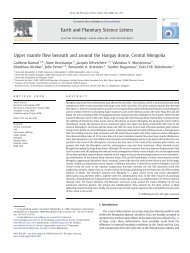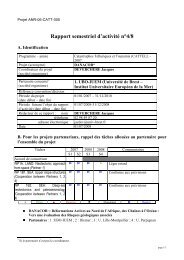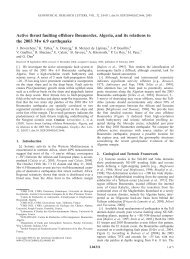Introduction - Remerciements - Plan - liste des personnes ayant une ...
Introduction - Remerciements - Plan - liste des personnes ayant une ...
Introduction - Remerciements - Plan - liste des personnes ayant une ...
You also want an ePaper? Increase the reach of your titles
YUMPU automatically turns print PDFs into web optimized ePapers that Google loves.
<strong>Plan</strong>, Résumé, <strong>Introduction</strong><br />
covering the Tunka-Baikal area provi<strong>des</strong> insights on some active faults : (1) the Sayan fault, a continous system along<br />
130 km, depicts at 3 points river offsets which attest for a recent sinistral strike-slip movement, which magnitude is still<br />
undetermined ; (2) the north-Tunka (West) presents discontinous, en-échelon segments with a variable size from 3 km to<br />
10 km and a probable compressional component; (3) the south-Tunka fault vanishes inside the basin from west to east :<br />
although different small segments are obvious, no clear, recent offsets are detected along them, suggesting a transfer of<br />
motion to the north on the Sayan and north-Tunka faults.<br />
2. GPS measurements and long term prediction of earthquakes<br />
Four campaigns of Global Positioning System measurements were performed between 1994 and 1998 in the<br />
southern and western Baikal region. Our results [4] show a total extension of 4.5+/-1.2mm/yr in a NW-SE direction in the<br />
southern part of the Baikal rift zone and a velocity gradient perpendicular to the major active faults, indicating elastic<br />
strain accumulation. This velocity rate is in good agreement with results of Holocene horizontal displacements on faults<br />
of the SBR [2, 3] but is at least two times greater than the prediction of most deformation models of Asia [5,6]. The strain<br />
is localized on a narrow (50 to 100 km wide) rift structure which appears to be concentrating the present-day deformation<br />
between Eurasia and East China. A comparison between the GPS results and the seismic moment released by historical<br />
earthquakes suggests that elastic strain is currently accumulating in the Baikal rift zone along active faults that have the<br />
potential for a M = 7.5 earthquake if that elastic strain were to be released in a single event today. If aseismic slip is<br />
neglected, we hypothesize recurrence intervals of 150-350 years for large (M~7.5-7.7) events along the lake shoreline,<br />
which could imply the occurrence of a strong shock in the near future. In the South and Central Baikal region, field<br />
<strong>des</strong>cription of more than 40 paleoscarps, and radiocarbon datings of seismogenic deformations have provided<br />
recurrences of less than 2000 years [7], a value similar to the one found in the North [3]. We are currently extending our<br />
GPS network to Mongolia, where 20 sites covering the western half of the country have been measured for in 1997 and<br />
1998. First results favor an eastward movement of the Mongolian block. These results could reflect the dynamic effect of<br />
the Pacific-Eurasia subduction in addition to the well-kown effect of the the India-Eurasia collision. Other causes could<br />
be a "ridge push" effect below the rift, or a buckling of the lithosphere in response to collisional tectonics along the<br />
Siberian Craton. We need additional GPS measurements and tests of dynamic deformation models to discriminate<br />
between these possible effects.<br />
3. Deviatoric stress changes<br />
The problem of the forces responsible for the opening of the Baikal rift is still enigmatic. Analyses of individual<br />
strain directions provided by focal mechanisms of earthquakes is a classical way to determine the consistency of fault<br />
kinematics. We have considered useful to proceed to local deviatoric stress inversions as often as possible, and then to<br />
use these tensors to predict slip directions along main faults. More than 300 focal mechanisms located along the whole<br />
Baikal rift were first used [8]. The stress field is varying at different scales of observation: when looking at central Asia,<br />
the maximum horizontal stress Shmax directions remain rather constant (with a fan-shape geometry) when the tectonic<br />
regime goes from transpressional (Mongolian Altai) to extensional (Baikal). At the scale of the Baikal rift, clear variations<br />
of the stress regime are observed, from an extensional regime in the central part of the rift to wrench ones in its northern<br />
and southern ends. Finally, at the scale of 100 km, systematic Shmax reorientations occur close to major rift faults. We<br />
thus infer that the interaction between collisional processes and inherited structures may have a strong influence on rift<br />
dynamics. Predicted slips show two distinct parts of the rift: the South Baikal Rift is characterized by a constant trend<br />
(around N100°E), meanwhile the North Baikal Rift exhibits rotations involving at least three crustal blocks. These surficial<br />
structures and motions can be easily explained by an interaction between the regional compression linked to the India-<br />
Asia collision and the geometry of the hardly deformable Siberian platform. This suggests a large-scale cracking<br />
(releasing bend) of the lithosphere in the Baikal region. A plane, simple finite element model of deformation confirms this<br />
pattern at broader scale [9].<br />
Recently, we have analyzed stress changes from Lake Baikal up to the Bolnai fault in Mongolia thanks to a new<br />
database of reliable focal solutions of earthquakes (110 all-size mechanisms). There is a smooth, progressive change of<br />
Shmax from South to North, with a trend parallel to the N-S faults of the grabens of Busingol and Khubsugul. Only the<br />
Tunka basin region shows a quick change to a E-W strike. Elsewhere, the general strike is in agreement with a fanshaped,<br />
large-scale distribution of Shmax, consistent with the compressive stress field imposed by the India-Eurasia<br />
collision. Extensional regimes observed are explained by: (i) the position of Busingol, Darkhat and Khubsugul basins<br />
inside a block between two large strike-slip faults, suggesting a pull-apart or a tension gash mechanism within a<br />
transpressional regime ; (ii) the position of Lake Baikal against a major suture zone, which strike favors an opening<br />
controlled by the main Sayan fault linked to the eastward escape of the Mongolian block.<br />
6


